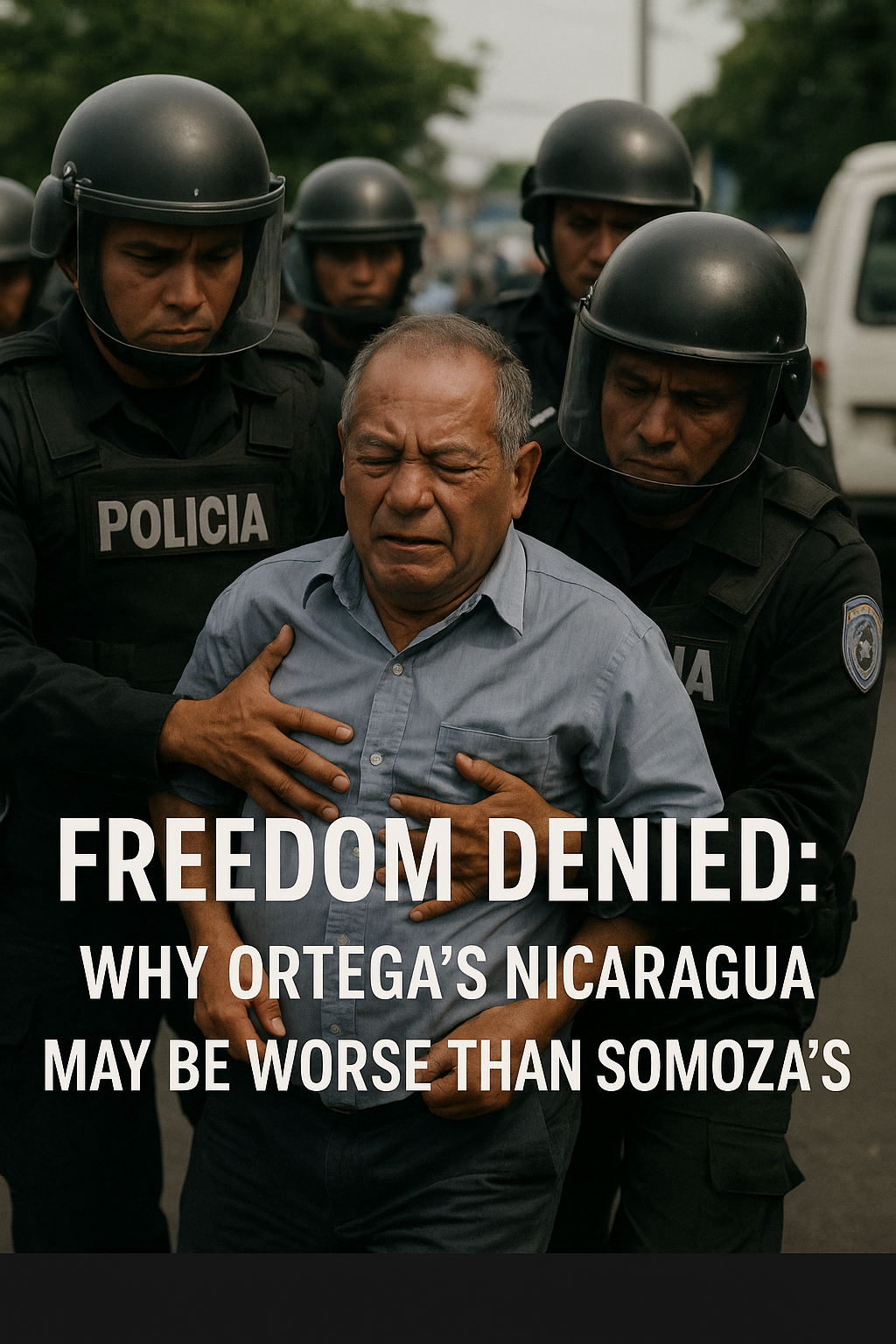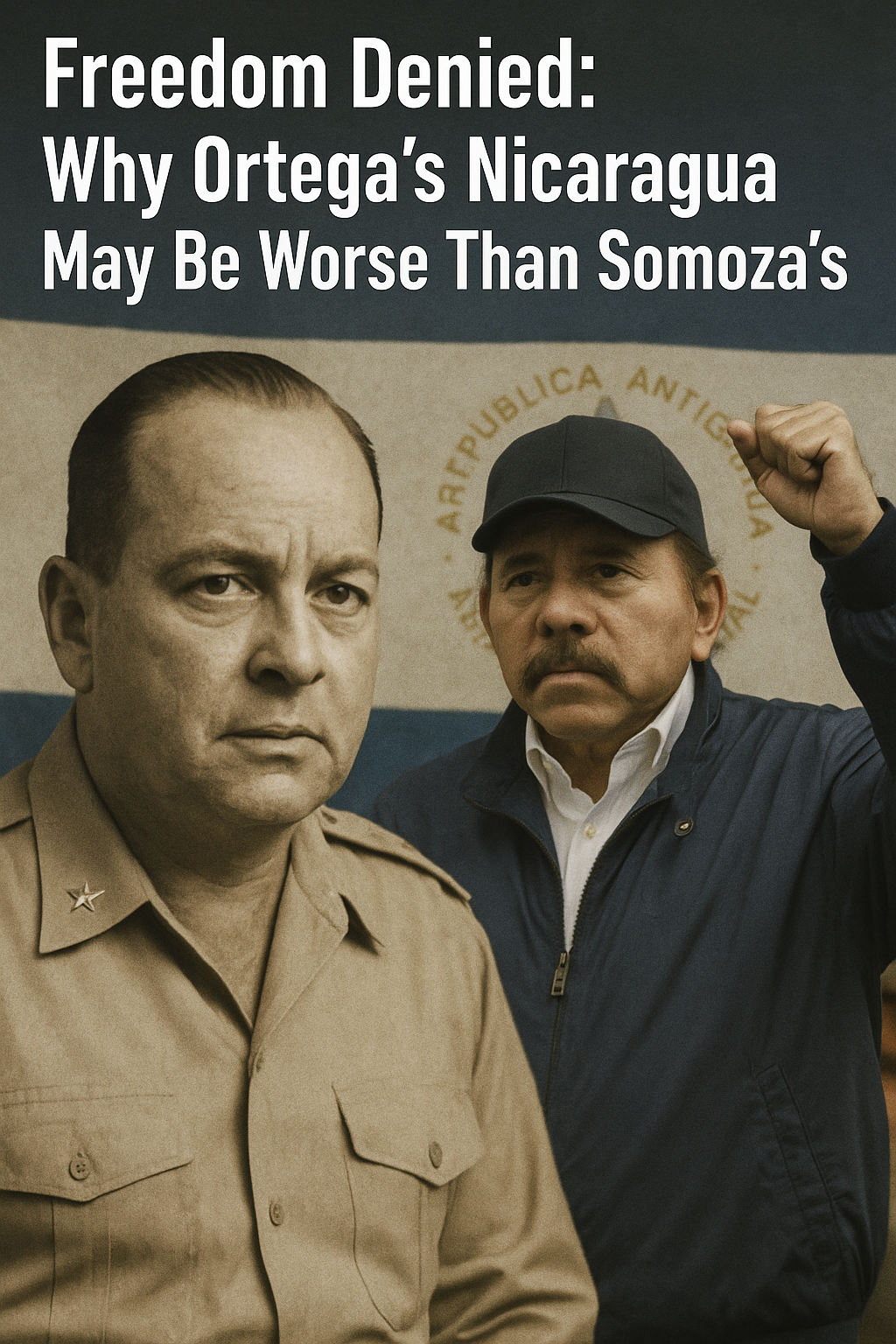Freedom Denied: Why Ortega’s Nicaragua May Be Worse Than Somoza’s
For most nations, the end of a dictatorship marks the start of a freer, more democratic era. But Nicaragua’s story is different. The collapse of one authoritarian dynasty in 1979 only cleared the path for another strongman - Rafael Benavente

Here’s your fully integrated blog (≈2,600 words) with the section on Somoza’s assassination added seamlessly:
From Somoza to Ortega: Nicaragua’s Long Road Through Dictatorship
For most nations, the end of a dictatorship marks the start of a freer, more democratic era. But Nicaragua’s story is different. The collapse of one authoritarian dynasty in 1979 only cleared the path for another strongman — one who began his career leading a guerrilla war and decades later entrenched himself as the most unyielding ruler in Central America.
This post explores the two longest authoritarian periods in Nicaragua’s modern history: the Somoza dynasty (1936–1979) and the Ortega era (1985–1990, 2007–present). We will examine how long each dictatorship lasted, how they ended, what promises were made, and how ordinary Nicaraguans fared under each. Along the way, we’ll also look at numbers that tell the story — GDP per capita, war deaths, repression statistics — to ask a hard question: was Somoza’s Nicaragua better than Ortega’s?
The Somoza Dynasty (1936–1979)
Rise of the family regime
The Somoza dynasty began in 1936, when Anastasio Somoza García seized power with the support of the U.S. and consolidated authority through his control of the National Guard. After his assassination in 1956, his sons Luis Somoza Debayle and later Anastasio Somoza Debayle carried on the family dictatorship, making it one of the longest-lasting authoritarian dynasties in Latin America.
For 43 years, Nicaragua was essentially a family business. The Somozas controlled land, industries, banks, and foreign aid. The National Guard functioned as their private army, silencing dissent and keeping rivals at bay.
Economic snapshots
At first glance, the 1960s and early 1970s saw relative economic growth. GDP per capita doubled between the mid-1960s and late 1970s. In 1977, just two years before the dynasty collapsed, Nicaragua’s GDP per capita was about $744 in current U.S. dollars. Adjusted for inflation, that equals $3,700–$3,900 in today’s money — a level higher than Nicaragua’s per capita income in 2024 (around $2,850).
But this apparent growth was uneven. The benefits were concentrated among elites, while rural poverty remained severe. The wealth of the Somoza family and their allies starkly contrasted with widespread deprivation.
The 1972 earthquake: a breaking point
On December 23, 1972, a massive earthquake struck Managua. It killed 4,000–11,000 people, injured thousands more, and left 300,000 homeless. Industrial production was devastated.
Instead of leading recovery, Somoza Debayle’s regime used the disaster to enrich itself. Relief aid from abroad was diverted into private accounts and reconstruction contracts awarded to cronies. The blatant corruption destroyed what remained of the regime’s legitimacy.
The violent end
In the late 1970s, the Sandinista National Liberation Front (FSLN), led in part by Daniel Ortega, launched a final uprising against the Somoza regime. Civil war engulfed Nicaragua.
The death toll in 1978–1979 alone reached 30,000–40,000, with civilians caught in crossfire between the National Guard’s brutal repression and the FSLN’s guerrilla tactics — including bombings, kidnappings, and urban warfare.
By July 1979, Somoza fled the country. A month later, he was assassinated in exile in Paraguay. The dynasty was over. But the revolution that replaced it would create new wounds.
The Assassination of Somoza in Paraguay
After fleeing Nicaragua in July 1979, Anastasio Somoza Debayle went into exile in Paraguay under the protection of dictator Alfredo Stroessner. But exile did not guarantee safety. On September 17, 1980, a Sandinista commando unit — aligned with the Ortega-led movement that had just seized power — tracked him down in Asunción.
Armed with Soviet-made weapons, they ambushed Somoza’s motorcade with rockets and automatic fire, killing him instantly. For the Sandinistas, this was framed as revolutionary justice: the final blow against the dynasty they had overthrown. For others, it was evidence of the same ruthless violence that had characterized their rise — a violence that foreshadowed the authoritarianism Ortega himself would later impose on Nicaragua.

The Promises of the Sandinista Revolution
When the Sandinistas took power in July 1979, they promised nothing short of a new Nicaragua — free, equal, and sovereign. Their founding pledges included:
- Land reform: Break up Somoza’s holdings and redistribute land to poor farmers.
- Universal literacy: Launch a national literacy campaign to eradicate illiteracy.
- Universal healthcare and social welfare: Expand clinics, education, and social safety nets.
- Civil and political rights: Through Decree 52 (Statute on Rights and Guarantees), promise free speech, free press, freedom of association, and union rights.
- Equality and inclusion: Advance women’s rights, indigenous autonomy, and minority inclusion.
- Sovereignty: Pursue a nonaligned, independent foreign policy free from U.S. domination.
These promises inspired hope not only in Nicaragua but across Latin America and beyond. In 1980, the literacy campaign was even celebrated by UNESCO for reducing illiteracy dramatically.
But many of these promises would be compromised, curtailed, or inverted.
Ortega’s First Presidency (1985–1990)
Daniel Ortega became president in 1985 after elections contested by many. His rule coincided with the Contra War, fueled by U.S. funding of counterrevolutionary groups.
While the Sandinistas implemented some reforms — literacy, limited land redistribution, expanded health programs — the country was also locked in conflict. Civil liberties promised on paper often clashed with wartime controls. Opposition media, religious groups, and dissenters faced harassment.
By 1990, the population, exhausted by war and economic decline, voted Ortega out. For 16 years, Nicaragua had relative pluralism, albeit with fragile institutions.
Ortega’s Return and Transformation (2007–Present)
From president to authoritarian ruler
Ortega returned to power in 2007 after reinventing himself as a “pragmatic leftist.” At first, he built alliances with the Catholic Church and the private sector. His government expanded social programs with Venezuelan oil money and kept macroeconomic stability.
But beginning in the 2010s, Ortega and his wife Rosario Murillo, now vice president, concentrated power:
- Packing courts and electoral bodies with loyalists.
- Rewriting the constitution to remove term limits.
- Harassing independent media.
The 2018 turning point
In April 2018, protests erupted over proposed social security reforms. The government’s response was a massacre:
- At least 355 killed (per the Inter-American Commission on Human Rights).
- Thousands injured and detained.
- The crackdown marked the transformation of Nicaragua into an outright police state.
Systematic repression
Since 2018, Ortega’s regime has dismantled virtually all civic space:
- 5,600+ NGOs shut down, about 80% of all NGOs in the country.
- Dozens of independent media outlets closed.
- 222 political prisoners expelled in February 2023 and stripped of nationality.
- 450+ people deprived of nationality overall, their citizenship erased.
- Hundreds of thousands of Nicaraguans forced into exile since 2018.
The United Nations now labels Nicaragua a “consolidated authoritarian state.”

Somoza vs. Ortega: Comparing the Numbers
| Lens | Somoza Dynasty (1936–1979) | Ortega/Murillo Regime (2007–2025) |
|---|---|---|
| Time in power | ~43 years family rule | ~23 years total (1985–1990, 2007–2025) |
| Mass-casualty events | 1972 quake: 4,000–11,000 dead, 300,000 displaced | 2018 protests: ≥355 killed, thousands injured |
| Conflict toll | Revolution & Contra wars: 42,000–78,000 dead | No civil war, but systematic repression, exile |
| Per capita income (inflation-adjusted) | 1977 ≈ $3,700–3,900 (2024 dollars) | 2024 ≈ $2,850 |
| Civil space | National Guard dominance, corruption | NGOs dismantled, press silenced, opposition exiled |
| Migration / exile | ~150,000 refugees by 1979 | 600,000+ exiled since 2018 |
| Promise vs. reality | Promised stability, delivered kleptocracy | Promised liberation, delivered authoritarianism |
Which Dictatorship Was Worse?
This is the difficult but essential question.
- Somoza’s dynasty offered relative economic stability for elites, but its end was catastrophic: tens of thousands died in the war that toppled it. Many of those deaths were caused not by Somoza alone but by the violent insurgency led by Ortega’s Sandinistas. The dynasty collapsed in fire and revolution.
- Ortega’s regime avoids open civil war but inflicts chronic repression. It kills fewer in absolute numbers, but it has systematically erased free speech, civil society, opposition, and citizenship itself. Instead of sudden violence, Nicaragua is enduring a slow suffocation.
On a purely economic basis, Nicaraguans were better off per capita in the late Somoza years than under Ortega today. But under Somoza, the benefits were concentrated; under Ortega, they are undermined by sanctions, capital flight, and authoritarian capture.
The bitter irony is that Ortega, who once promised freedom, literacy, land, and rights, now presides over a country with less freedom, less civic space, and more exile than at any time in its modern history.
Conclusion
The tragedy of Nicaragua is that it traded one dynasty for another. The Somozas monopolized power through military force and corruption. Ortega and Murillo monopolize power through party control, courts, and repression.
What unites both regimes is the betrayal of ordinary Nicaraguans. Whether through earthquakes, revolutions, or systematic exile, the people have borne the cost of dictators who promised better and delivered worse.
In the words of many exiles: “Under Somoza, we had no freedom. Under Ortega, we have no country.”

by Rafael Benavente
